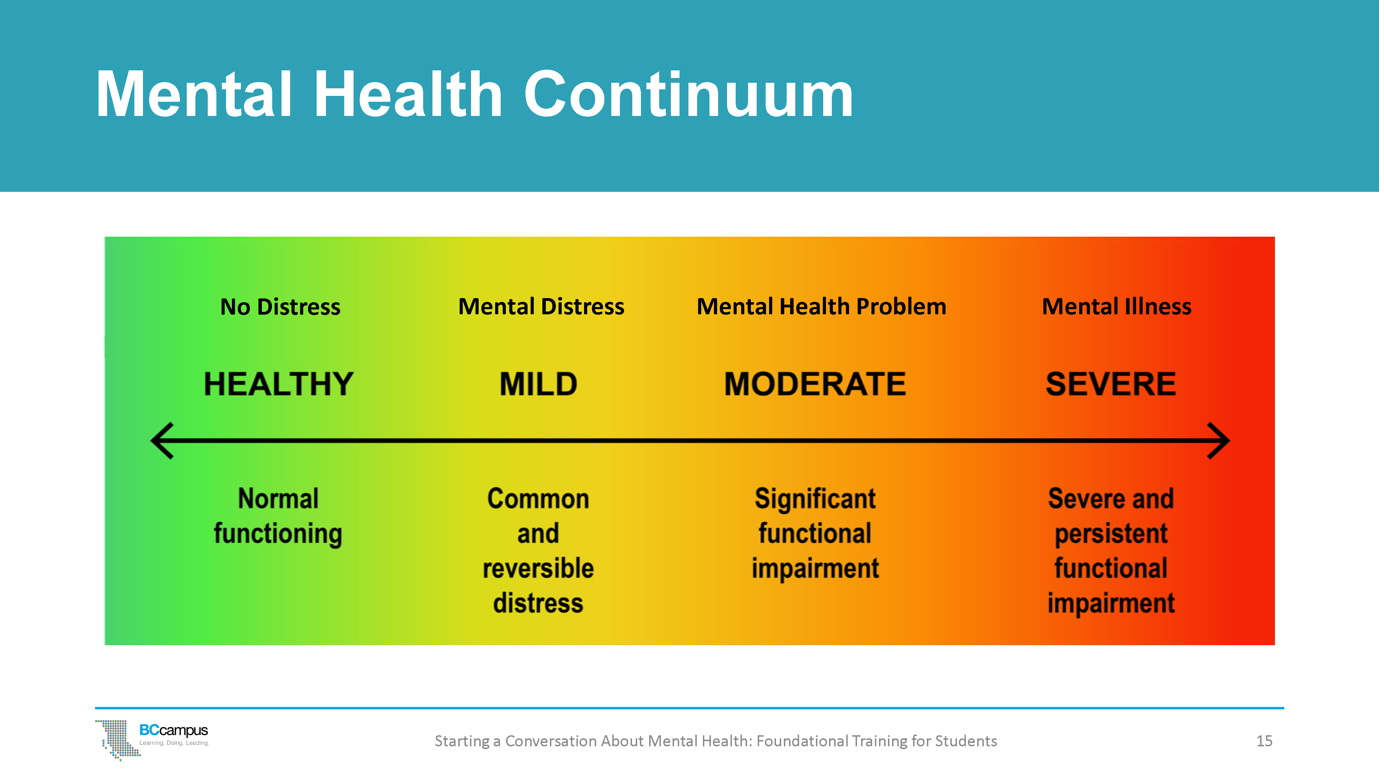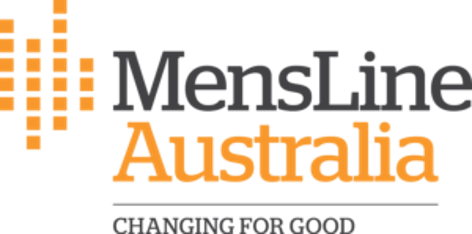What is Mental health?
The World Health Organisation (WHO) defines mental health as ‘a state of mental wellbeing that enables people to cope with the stresses of life, realise their abilities, learn well and work well, and contribute to their community’.
What is Mental Illness?
Just like our physical health, our mental health is on a continuum. The mental health continuum describes a range of states, with mental health and mental illness at the two extreme ends. Depending on internal and external influences, your mental health can lie at one point of the continuum and shift position as your situation improves or deteriorates.

Mental illness is defined as a ‘clinically significant disturbance in an individual’s cognition, emotional regulation, or behaviour’s’.
- Other terms used: mental health disorder, mental disorder, mental health condition.
- Mental illness needs to be clinically diagnosed.
- Diagnosis is based on the severity and duration of symptoms.
- It is important to note that you can experience poor mental health but not have a mental illness, and vice versa.
- People are living productive, purposeful and meaningful lives with mental health concerns.
How do I know if my mental health is suffering?
Whilst we can all, at times, feel overwhelmed and ‘stressed’, the key is to not ignore the signs when we experience this over an extended period of time. If we can recognise these signs early, we’re then able to stop and check in with ourselves to see how we’re travelling. The signs can be physical, emotional, behavioural and can be present in our personal lives and within the workplace. Here are some of the signs to watch out for within ourselves and those closest to us:
- I seem to be feeling anxious and worried more than I usually am
- I am feeling depressed and unhappy more than I usually am
- I seem to be having unusual emotional outbursts, such as extreme distress or anger
- I seem to be having trouble getting, or staying asleep
- I am experiencing unusual and inexplainable weight and appetite changes
- I don’t feel like engaging with others these days – I prefer to withdraw and isolate
- I seem to be taking more substances such as drugs or alcohol than I usually do
- I often feel worthless, guilty and or that I’m a failure.
If you are experiencing any of the above, seek the advice and support of someone you trust to discuss and take action.
How common is Mental Illness in Australia?
The latest data from the Australian Bureau Statistics (ABS) was released on 05/10/2023 for the period covering 2020 – 2022. The data shows:
- 42.9% of people aged 16–85 years had experienced a mental disorder at some time in their life. That’s 2 in 5 people.
- 21.5% of people have had a mental disorder within a 12 month period, with Anxiety being the most common group (17.2% of people aged 16–85 years). 1 in 5 people.
- 38.8% of people aged 16–24 years had a mental disorder within a 12 month period. 3 in 5 young people.
What are the Most Common Mental Health Illnesses in Australia?
ABS data shows that the most common mental disorders in Australia in any 12-month period are:
- Anxiety disorders (3.4 million people or 17.2% of the population)
- Panic disorders (3.7%)
- Agoraphobia (4.6%)
- Social Phobia (7.0%)
- Generalised Anxiety Disorder (3.8%)
- Obsessive Compulsive Disorder (3.1%)
- Post-Traumatic Stress Disorder (5.7%)
- Affective (mood) disorders (1.5 million or 7.5%)
- Depressive Episode (4.6%)
- Dysthymia (1.7%)
- Bipolar Affective Disorder (2.2%)
Females experience higher rates than males of Anxiety disorders (21.1% compared with 13.3%) and Affective disorders (8.6% compared with 6.5%)
Anxiety Disorders
When you have an anxiety disorder, it has an impact on your life that’s so marked that it makes it hard to go about your daily activities and responsibilities. Sometimes severe anxiety can develop over time and we may not notice how it’s affecting us. Someone else may notice first.
There are many types of anxiety disorders and they share are some common signs and symptoms. You can read more about them in this fact sheet from Black Dog Institute.
Post-Traumatic Stress Disorder (PTSD)
PTSD is a type of anxiety disorder that involves feelings of fear, sadness, anger and grief following exposure to a a traumatic event. Potentially traumatic events involve actual or threatened death, serious injury, or sexual violence to ourselves or others. They may make us feel fear, helplessness or horror. Everybody responds differently to terrible events. Some traumatic events happen over a long period of time, such as sexual abuse as a child, imprisonment or torture. Others can be a single event, such as a terrible car accident.
Much of our workforce have potential to be exposed to traumatic events due to the nature of the work we do. It is important for us to understand the signs and symptoms of PTSD, and to know how we can seek / offer support. You can read more about PTSD in this fact sheet from Black Dog Institute.
Affective (Mood) Disorders
Depression
Depression is the most common affective (mood) disorder. Depression can cause a low mood that doesn’t go away and can make us feel very sad or withdrawn. It interferes with the way we go about our everyday lives and can make it hard to cope.Some people describe it as being in a really dark place that’s difficult to come back from. Others describe it as feeling numb.
You can read more about the signs and symptoms of depression in this fact sheet from Black Dog Institute.
Click here to view a short video about the “Black Dog”.
Dysthymia
Dysthymia is a milder, but long-lasting form of depression. It’s also called persistent depressive disorder. People with this condition may also have bouts of major depression at times.
You can read more about the signs and symptoms of Dysthymia in this fact sheet from John Hopkins Medicine.
Bipolar Disorder
A person with Bipolar Disorder has episodes of depression and highs (feeling ‘hyper’ or ‘wired’). During the ‘highs’ they might feel like things are speeding up, having thousands of thoughts and ideas, and they may feel invincible or behave recklessly.
You can read more about the signs and symptoms of Bipolar Disorder in this fact sheet from Black Dog Institute.
Where to find Support
![]()
There are a wide range of support options available to you, including:
- Someone you trust from your private or work life
- Your manager (or another manager)
- A member of the HSE team or the C&P team
- Lifeline online, or call 13 11 14
- Beyond Blue online, or call 1300 224 636.
- Other options as listed below:
Health professionals
Talk to your doctor about your concerns and ask for an assessment or referral. Some general practitioners (GPs) have additional training and expertise in mental health.
Medicare rebates are available for a range of mental health treatments, including up to 10 individual consultations and up to 10 group therapy sessions with a mental health professional. You’ll need a referral from a general practitioner, psychiatrist or paediatrician to be eligible.
You can use the online resources listed below to research health professionals.
Online
Aspen Medical’s Employee Assistance Program (EAP) run by Assure
- Need help? Whatever you need, we’re here to support you.
- Access confidential support and coaching delivered by experienced health professional across a wide range of work, health, family, and life issues at no cost to you.
eMHPrac
The eMHPrac team consists of clinical psychologists, researchers and support staff, all with a commitment to promoting and supporting the integration of digital mental health into routine practice. The team are based at Queensland University of Technology in the Addiction and ePsychology Research Group. They are part of the Institute of Health & Biomedical Innovation and the School of Psychology & Counselling in the Faculty of Health.
eMHPrac have published an e-Mental Health Directory. This a a web version of the popular eMHPrac Guide to Digital Mental Health Resource booklet.
The eMHPrac website provides access to a range or resources, including podcases, fact sheets and apps.
TIP: Bookmark this page for future reference. This is an amazing resource with links to dozens of different support services covering all demographics and mental health issues.



TEN – The Essential Network for Health Professionals
- Designed by health professionals, for health professionals, The Essential Network (TEN) makes accessing support quick, easy and confidential.
Social and emotional wellbeing resources for First Nations people
- The Aboriginal and Torres Strait Islander Lived Experience Centre elevates the voices of First Nations people and shares their stories to co-design, inform, and deliver culturally safe mental health and suicide prevention initiatives.


